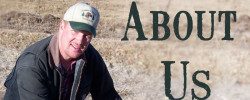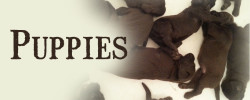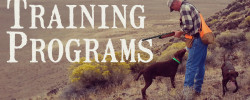 At Cabin Creek Gun Dogs we get a lot of folks asking for advice when it comes to potty training your pup. Potty training your gun dog pup begins the day you bring it home. Actually, potty training your puppy starts before you bring it home. Being prepared to successfully potty train a puppy starts with having strategically placed kennels and pens near doors, for quick access. Potty training also starts by having one door with a direct connection to the outside where the dog will learn to go when it needs to potty.
At Cabin Creek Gun Dogs we get a lot of folks asking for advice when it comes to potty training your pup. Potty training your gun dog pup begins the day you bring it home. Actually, potty training your puppy starts before you bring it home. Being prepared to successfully potty train a puppy starts with having strategically placed kennels and pens near doors, for quick access. Potty training also starts by having one door with a direct connection to the outside where the dog will learn to go when it needs to potty.
Consider starting with two kennels in the house for a new pup. One kennel is placed near the door where the pup will exit to go potty. The other is placed on a table or bench near your bed, where the new pup sleeps at night. Placing the bedtime kennel at eye level is a good idea, so the pup feels comfortable and where you can keep an eye on it throughout the night. This is not only a good way to monitor when the pup needs to go potty, but also to establish sleep patterns as it grows. This setup also allows bonding to develop between you and the pup.
A seven or eight week old puppy plays hard, then crashes. Before it falls asleep, take it potty. When the pup is sleeping, never wake it up to go potty. But as soon at the puppy awakens, get it out the door as soon as possible. Decide on a potty command that everyone in the family uses. You want your dog to learn how to urinate on command. Go potty is a common command, and everyone in the house should deliver the command with consistent inflection.
For the first week or two, it’s a good idea to physically carry the puppy outside, placing it where you want it to potty. Once it establishes a place to potty, it will keep going to that same spot.
 After a couple weeks, when the pup awakens from a nap, take it out of the daytime kennel or pen, positioned by the door, and let it walk outside to potty, on its own. This will help it learn that when it has to potty, to go to the door and walk to the established site. Promptly reward the puppy with praise and petting. At this young age, physical contact is a big part of developing a bond between you and your dog, and positive reinforcement is the key to quick potty training.
After a couple weeks, when the pup awakens from a nap, take it out of the daytime kennel or pen, positioned by the door, and let it walk outside to potty, on its own. This will help it learn that when it has to potty, to go to the door and walk to the established site. Promptly reward the puppy with praise and petting. At this young age, physical contact is a big part of developing a bond between you and your dog, and positive reinforcement is the key to quick potty training.
During the day, place the pup in a pen, near you. This gets it used to sleeping in a different place, allows you to keep an eye on it, and develops further bonding. When the puppy wakes up, immediately take it outside to potty.
When the puppy is awake, take it outside to potty every 20-40 minutes. Male pups have to potty more frequently than females, so every 20 minutes is not an overkill with a young pup. Calling them to the door, in the middle of play time, is a good way teach them to go to the door when they have to potty, and is also the start of teaching them the command to come.
At night, for the first week or so, when the pup is sleeping in the bedside kennel, take it out as soon as it begins to stir, every two to three hours is common at this stage. This will teach the puppy that it’s not okay to potty in the kennel.
After a few weeks of going potty out the same door of the house, start changing things up. Begin taking it out different doors and having it potty in different places, even on different surfaces.
You don’t want a dog that always has to potty on grass and only grass. Having a pup that will potty on gravel, sawdust, rock, dirt, even on pavement, ensures that as it matures it will potty on command, wherever you are.
In order to prevent accidents, after about a month of age, don’t give the pup water two to three hours before bedtime. As a growing pup they need water, just limit it at night time.
 Once the pup gets comfortable with going potty as soon as it gets outside, start carrying it to where you’ll eventually want it to relieve itself as an adult, usually further from the house. This will prevent the pup from doing its business next to a sidewalk and killing the grass. It’s nothing for a dog to go 50 yards or more before going potty, but you have to teach them that, early. As they mature, and you teach your pup verbal signals and hand signals, you’ll be able to direct them to exactly where you want them to potty, at whatever distance.
Once the pup gets comfortable with going potty as soon as it gets outside, start carrying it to where you’ll eventually want it to relieve itself as an adult, usually further from the house. This will prevent the pup from doing its business next to a sidewalk and killing the grass. It’s nothing for a dog to go 50 yards or more before going potty, but you have to teach them that, early. As they mature, and you teach your pup verbal signals and hand signals, you’ll be able to direct them to exactly where you want them to potty, at whatever distance.
Before you bring that pup home, have a potty training plan in place. Be patient and positive, and don’t scold a pup for any accidents it has in the house for the first month or so. If you catch it in the act, sternly say “no,” pick it up and carry it outside to finish its business. Accidents will happen, and positive reinforcement will see better, quicker results than negative ones that will stress a pup and inflict uncertainty.
Good luck with your new puppy, and be sure to check out more training tips that we offer at Cabin Creek Gun Dogs. We strive to provide a lot of information on both our Blog and through videos in order to help you get the best experience when it comes to training and hunting with your gun dog.


